Pixless Camera Turns Low Resolution Into High Creativity
- Michael G.

- Dec 29, 2024
- 4 min read
Updated: Aug 20
The Pixless Camera is a digital rebel. While the world chases higher megapixels and AI-enhanced filters, this bold little Kickstarter project goes the other way—delivering just 0.03 megapixels and embracing pixel art as an aesthetic. But this isn’t a gimmick. It’s a fully functional, Wi-Fi-enabled, open-source camera that celebrates simplicity and creativity in one elegant device.

A Radical Rethink of Digital Photography
The idea behind the Pixless Camera is brilliantly simple: strip photography down to its most essential element—your point of view. Forget sharpness and image fidelity. With its 0.03MP sensor, this camera transforms photos into pixelated images that feel more like digital art than snapshots. The result? A nostalgic throwback to early digital art with just enough modern tech to make it fun, functional, and addictive.
Creator Carlo Andreini, a self-taught designer, photographer, and programmer, set out to prove that art doesn’t need resolution. “Photography is not about megapixels,” he says, “but capturing reality from your own perspective.” His work proves that point in spades.
The Hardware That Makes It Possible
Despite its retro concept, the Pixless Camera is far from low-tech. Inside its stylish 3D-printed PA12 nylon shell, you’ll find an ESP32-S3 processor and an OV5640 sensor. It has a 35mm full-frame equivalent focal length and F2.4 aperture. The compact body—just 84x46x23 mm—is sleek, scratch-resistant, and easy to carry anywhere. You can truly fit this creative powerhouse in your pocket.
The camera also supports Wi-Fi, allowing for image transfer, palette uploads, and live viewing directly from your phone via a built-in hotspot—no app required. That’s right: Pixless works through a browser-based interface, meaning it will keep working even if the company behind it vanishes someday. This is part of its philosophical design: permanence and independence.
Pixel Art Photos with Custom Palettes
What makes the Pixless Camera stand out is its ability to generate beautiful pixel-art images using custom palettes. Users can download palettes in .hex format from sites like LOSPEC, and then import them into the camera’s file system. When a photo is taken, the image is processed line by line, mapped against the chosen color palette, and enlarged for clarity without blur. The result: bold, colorful visuals that feel like they were pulled from an old-school video game.
This is where digital photography becomes play. By experimenting with different palettes, users can create wildly different moods and styles from the same scene.
Pixless Camera. No App. No Bloat. No Limits.
Too many smart devices today rely on proprietary apps. Lose access to the app, and the hardware becomes a paperweight. Not the case with the Pixless Camera. All features are accessible via a browser, hosted locally by the camera itself. Once you connect to the Pixless Wi-Fi network, you’ll be taken to a simple web interface where you can view images, change settings, or even control the shutter remotely.
This design choice might sound small, but it’s huge for long-term usability. It also means no forced updates, no app permissions, and no limits. Just your camera, your browser, and your creative instinct.
Designed for Makers and Modders
One of the most exciting parts of the Pixless Camera is its commitment to customization and repair. It’s not just encouraged—it’s designed into the product. All key parts are easily replaceable: battery, OLED screen, camera module, shell, and even the mainboard. The team also plans to release the internal 3D files, enabling users to print their own shells in different colors and materials.
This “right to repair” mindset is rare in consumer electronics, especially in cameras. It makes Pixless perfect for DIY tinkerers, electronics hobbyists, and people who just love to understand the tools they use.
Constantly Improving Through Prototypes
The Kickstarter campaign documents the journey from the early Raspberry Pi Zero 2W prototype to the current model. Prototype 0.23 was limited by its hardware: an ESP32-CAM and an OV2640 sensor, which lacked the color depth and stability needed for consistent results. It also had slow image processing and a complex assembly process.
The team learned fast. They upgraded to a better sensor, integrated a custom PCB, and switched to a faster CPU—all while keeping the camera small and efficient. With each new prototype, the Pixless Camera got more capable without compromising its core identity.
Forward-Looking Plans
This campaign isn’t just about one quirky camera. The team is already considering a Pro Version, which could feature a wider lens, a full-color near-eye EVF, and manual controls for ISO and exposure. That would take the Pixless concept into even more professional territory, while still holding onto the project’s minimalist soul.
Why Back Pixless Camera on Kickstarter?
You’re not just buying a gadget. You’re backing a philosophy. The Pixless Camera is a protest against the bloated tech race—a quiet, pixelated rebellion that asks us to slow down and create something meaningful.
It’s also a great creative tool for:
Pixel artists looking for real-world image sources
Hobby photographers who want to challenge their habits
Retro lovers who adore the aesthetic of 8-bit and 16-bit imagery
Educators introducing students to the basics of sensors, hardware, and digital image processing
Makers and hackers who want to remix and modify their gear
Backers get early access to a limited, handcrafted camera with an actual use case. The price is fair (€70), and you’re directly helping to shape the final product through your support and feedback.
A Pixelated Statement
In a world obsessed with specs, the Pixless Camera is a refreshing reminder that creativity isn’t about the tools—it’s about how you use them. Whether you’re capturing urban decay in pixel art form or making digital portraits with 32 colors, this Kickstarter gem invites you to see the world differently. It’s small. It’s strange. And it’s wonderful. Support the campaign on Kickstarter and take photography back to its pixel roots.



















.png)











